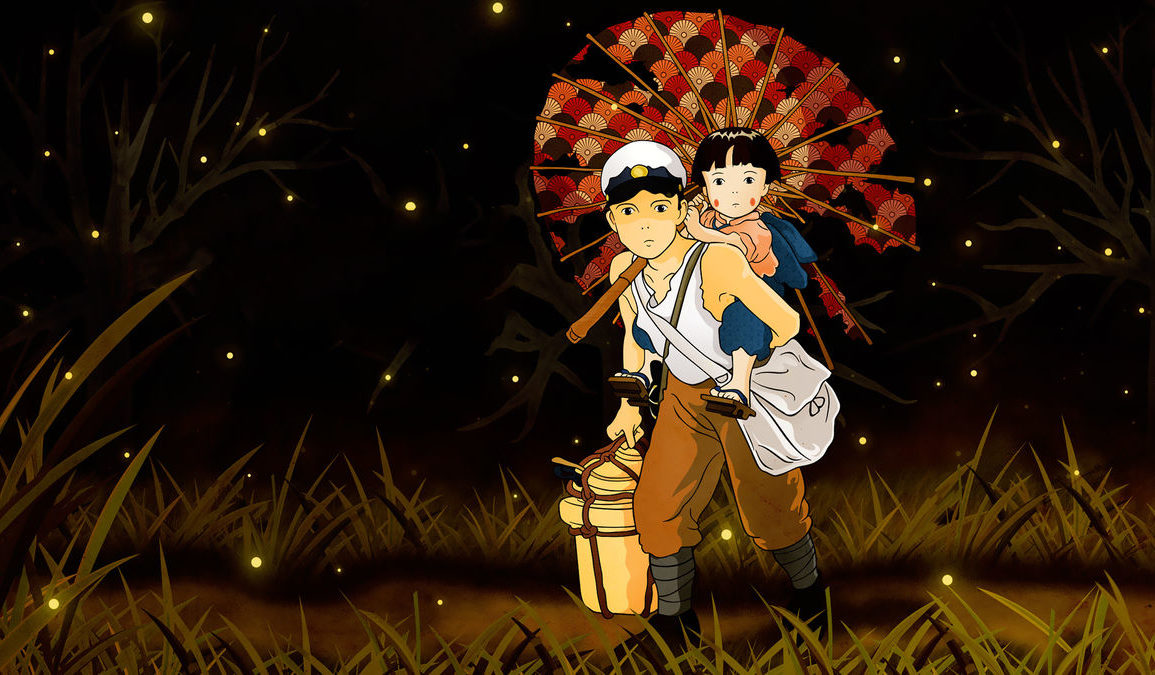In 1988, one of the most powerful films of all time hit theaters in Japan. Although an animated feature, Isao Takahata’s Grave Of The Fireflies immediately resonated with audiences and continues to touch viewers today.
I myself was a little hesitant to revisit this film, and for good reason. Grave Of The Fireflies is a film adaptation of a semi-autobiographical short story by Akiyuki Nosaka, who survived the firebombing of Kobe, Japan during World War II. His mother perished in the attack and his little sister, Keiko, succumbed to malnutrition. Nosaka would pen a short story in Keiko’s memory years later, and it would serve as the basis for Takahata’s film.
Grave Of The Fireflies opens with the firebombing of Kobe in 1945. On the ground are 14-year-old Seita and his 4-year-old sister, Setsuko. After losing their mother to the firestorm, Seita and Setsuko are forced to seek refuge with an emotionally abusive aunt. Faced with less-than-ideal living conditions, Seita takes Setsuko into an abandoned air raid shelter, where they choose to live as free spirits. Ultimately, Seita’s decision to live away from civilization will impact their lives, for better and worse.
Takahata’s film is infamously heartbreaking. The story of two orphan children in the middle of a war is hard to stomach. We feel for Seita as he’s forced to grow up for the sake of his sister. With most adults either unsympathetic or trying to survive themselves, Seita’s struggle is both captivating and crushing as he navigates through this new world that ignores the plight of orphans.
His little sister Setsuko is easily the most compelling character in the film. She’s a child completely unaware of what’s going on in the world around her. All she knows is her Mom is not around and she has no house. Amidst aerial bombardment and food rationing, she learns how to cope with this new life at the age of 4. As hard as it is to watch, seeing Setsuko go from a child playing with dolls to a little girl making rice balls out of mud for her big brother is also touching.
One does not need to be familiar with the history of World War II or Imperial Japan before watching this film. Part of the film’s genius is the fact that it doesn’t give us exposition about the war or over-the-top monologues about how war is bad. We learn about the circumstances by witnessing Seita and Setsuko’s experiences. Two nations are at war and these two are caught in the middle of it.
As an animated film, Grave Of The Fireflies is a remarkably beautiful film to watch. The animators made good use of bright colors to keep an otherwise war-torn environment lively. Seita and Setsuko are on their own, but against a backdrop of green forests and blue rivers, which leaves us hopeful that they can make this semi-nomadic life work. Even when aerial bombardments turn this serene atmosphere into a ghastly brown hellscape, the visuals are still stunning.
In many ways, Grave Of The Fireflies is as much a story of hope as it is about the loss of innocence. The film explores how people adapt to the most extreme circumstances, including children. Time and again, Seita and Setsuko find moments to play and be youngsters again. The two go to the beach and construct a small swing set for Setsuko to play on. In the safety of their shelter, Seita and Setsuko bond over captured fireflies, which represent the innocence still present in a grisly world.
Interspersed throughout the story are seemingly random moments, be it Seita eating plums or Setsuko exploring the world around her. These moments don’t seem like much, but that’s a key element of the film. The simplest of things we take for granted suddenly gain meaning in times of peril.
In his review of the film, Roger Ebert reminds us that animated characteristics – namely big and exaggerated eyes – help bridge the gap between a cartoon and the real world. It also helps create a deeper bond with the characters. Their eyes convey so many emotions and we share these emotions with them. Seita and Setsuko may be animated characters, but any reasonable viewer will desire to intervene in their plight.
More importantly, these animated characters embody real people. The sight of American bombers and Japanese naval vessels reminds us that Takahata’s film is a period piece and that, yes, children like Setsuko and Seita existed. Once this fact becomes clear, Grave Of The Fireflies becomes a more powerful viewing.
Almost 40 years after its release, Isao Takahata’s film remains an emotional and gripping watch. Viewers will no doubt be touched by Seita and Setsuko’s journey, and they will learn to appreciate the simpler things in life along the way.
READ NEXT: 15 Best Animated Movies You Should Watch
Some of the coverage you find on Cultured Vultures contains affiliate links, which provide us with small commissions based on purchases made from visiting our site.

